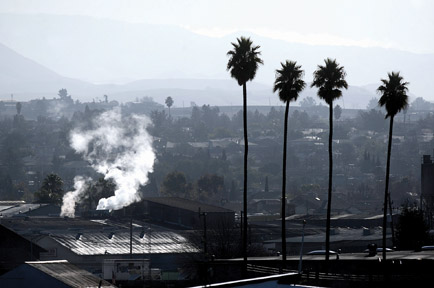Wood burning allowed unfettered in San Benito, unlike
neighboring counties
Wood burning allowed unfettered in San Benito, unlike neighboring counties
Northern San Benito County and southern Santa Clara County are separated by an invisible border, but the difference between the two in terms of wood-burning restrictions is clear.
Bay Area counties north and east of San Benito can, depending on weather conditions, be prohibited by government agencies from burning wood or other solid fuels in fireplaces, wood stoves and inserts, pellet stoves or other wood-burning devices. Those so-called “Spare the Air” rules don’t apply here.
Fireplace-usage bans have been commonplace in the Bay Area and San Joaquin Valley this winter, as stagnant, cold air settled over the region while blustery, air-scrubbing storms have stayed to the north.
“This winter has been a perfect storm of conditions that have caused rapid deterioration of air quality, including in the Monterey Bay area,” said Richard Stedmen, the air pollution control officer for the Monterey Bay Unified Air Pollution Control District, which monitors air quality in the region. “A lot of wood use has been undertaken because of the cold weather nights. And because of the economy, people are turning to wood to heat their homes because it is fairly cost effective.”
Until the recent return of rain, days have been cold and relatively windless and nights have been still and chilly, all of which traps smoke and other particulates in valleys and creates unhealthful air.
“Our cold winter nights have been very stagnant and inversion layers traps pollutants close to the ground,” Stedman said. “It can take only one person burning poorly or with a bad stove to affect a whole neighborhood. Even with Spare the Air days, we have been experiencing some of the worst air quality events in the last decade.”
Air quality officials in the San Joaquin Valley, east of San Benito County, “have been very active writing tickets” for people who ignore burning restrictions, Stedman said.
The California Department of Forestry and Fire Protection recently rescinded its ban on outdoor burning in several Central Coast counties, including San Benito. Since the day after Christmas, the ban on outdoor debris burning was prompted by dry conditions and concerns over fire danger, more than just air quality. Following the recent rainfall in the area, CalFire lifted the ban last week.
So why are San Benito County residents allowed to use their fireplaces without restrictions while their neighbors face strict rules? The simple answer, Stedman said, is that the county is in a different air basin than the Bay Area counties to the north, where the air quality tends to be worse in the winter.
“I recognize that air doesn’t respect boundaries,” he said. “The nine-county jurisdiction Bay Area Air Quality Management District doesn’t meet state and federal standards for air quality,” and thus is more heavily regulated.
The Monterey area air district, on the other hand, regularly meets most of those air quality metrics – except for Pinnacles National Monument, which often violates state ozone standards because of “transportive” pollution swept into the region from the Bay Area and San Joaquin Valley.
Staff and budget size also impact the ability to regulate local burning, Stedman said.
The Bay Area air district “is over 10 times our size in staff and they have people who can enforce Spare the Air days restrictions and investigate illegal backyard burning and fireplace usage,” he said. “This is one of those unfunded mandate programs we have. There’s no money we have for enforcing that.”
Instead, the air district hopes to educate residents in the Monterey Bay area about proper burning techniques as well as offering wood stove change-out incentives.
“We have the authority for enforcement, but we’re taking more of an educational, public outreach stance,” Stedman said. “People shouldn’t burn wet, dirty wood. We’re telling folks to burn clean, dry, seasoned wood and make sure a fire is getting a lot of oxygen so it doesn’t turn into a smoke-generator.”
As a general rule, fires are relatively clean burning if smoke is not visible coming out of a chimney.
“It only takes one person burning poorly or with bad stove to affect a whole neighborhood,” he said. “Wood smoke will really tip the balances on a regional scale. We traditionally deal with things on a county-wide or basin-wide level. We’re not good at dealing with a neighborhood level. The best approach is to let people know there is a correct way to burn.”
The Monterey Bay Unified Air Pollution Control District’s website offers a number of resources on wood burning and air quality recommendations. For details, see mbuapcd.org.










